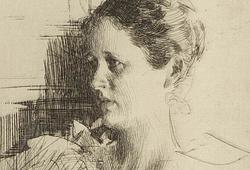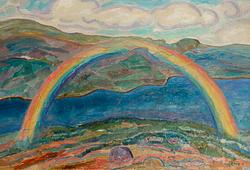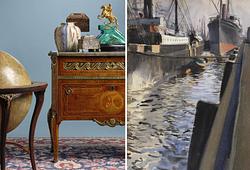Anders Zorn
Anders Zorn, "Överste Lamont I"
Etching, 1900, signed in pencil. P. 22.4 x 15 cm.
Not examined out of the frame.
Literature
Asplund 158, Hjert & Hjert 106.
More information
Daniel Scott Lamont (February 9, 1851 - July 23, 1905) was the United States Secretary of War under Grover Cleveland's second term. He was employed as a clerk in the Democratic State Central Committee in 1872 and served as the head of the New York State Department from 1875 to 1882.
In 1883, Lamont was appointed by his mentor Daniel Manning to then-New York Governor Grover Cleveland's staff as a political adviser. He became private and military secretary with the honorary rank of colonel in the governor's staff that same year and continued in his service after Cleveland became president in 1885. Lamont also held a position with William C. Whitney in his business ventures in 1889.
From March 5, 1893, to March 5, 1897, Lamont served as the United States Secretary of War in President Cleveland's cabinet. Throughout his tenure, he advocated for the adoption of an infantry regiment with three battalions as part of a general modernisation and strengthening of the army. Additionally, Lamont recommended the construction of a central archive building to house army records and urged Congress to approve the marking of important battlefields.
It was through Lamont that Zorn received the commission to portray Grover Cleveland (see etching no. Asplund 144 Cleveland).
Artist
Anders Zorn, born in Mora in 1860, showed artistic talent from a young age. In 1875, he traveled to Stockholm and became a student at the then Slöjdskolan (now Tekniska högskolan) in Stockholm, and shortly after, he joined the Royal Academy of Fine Arts. Initially, Zorn had aspirations of becoming a sculptor, but soon watercolor painting took over, becoming his primary medium until 1887. At the student exhibition in 1880, Zorn had his breakthrough with the watercolor painting "I sorg." The following year, he gained international acclaim as a portrait painter. His watercolor painting reached its pinnacle during this period, and his most famous work from this time is "Vårt dagliga bröd” from 1886. Shortly thereafter, Zorn transitioned to oil painting, which was met with immediate success. Zorn's reputation mainly rested on his portrait art, and he portrayed many notable figures, including presidents. For instance, he created an etching of Theodore Roosevelt. His etchings significantly contributed to his success. In the late 1880s, Zorn began working in the genre that would increasingly become his trademark: nude figures in outdoor settings. He had long been fascinated by the movement of water and the reflections of light on its surface. Now, he added the complexity of placing a model near or in the water, aiming to depict a synthesis between nature and humanity. In 1896, Zorn and his wife moved back to Sweden and settled in Zorngården in Mora. This move sparked a renewed interest in his homeland, which would be reflected in his future paintings. Among the artist's scenes from the Mora region, portraying its local customs and ancient traditions, "Midsommardansen" holds the highest value according to Zorn himself. Today, the painting can be found at the National Museum.
Read more

































